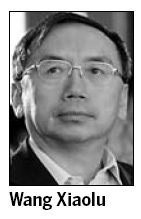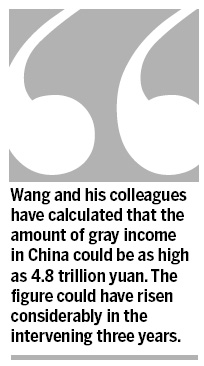Op-Ed Contributors
Gray areas of income revealed
By Wang Yiqing (China Daily)
Updated: 2010-06-03 07:49
 |
Large Medium Small |

Most people in China are familiar with the term "gray income" but have seldom tried to find what it really means. Wang Xiaolu, deputy director of the National Economic Research Institute, affiliated to China Reform Foundation, is one of the welcome exceptions. In fact, he has been studying the impact of gray income on China's economy, as well as society for some time now.
The media describes Wang as "the first scholar to conduct systematic research on gray income". He started the study when he was in charge of an investigation into the distribution of national income and gray income that was released in 2007. Not surprisingly, his report shows a huge gap between China's highest-income and lowest-income groups (55 times), which was significantly wider than the National Bureau of Statistics' (NBS) figure (21 times).
The serious difference between the two studies, according to Wang's analysis, can be attributed to the NBS' failure to take into account the huge amount of gray income in the country.
Since NBS studies are large-scale national projects, the bureau uses random sampling through its Urban and Rural Household Survey to collect data on income. Although statistically acceptable, the voluntary survey faces a peculiar problem: Investigators find it difficult to get information on "invisible income", because people are not willing to disclose it to strangers.
Wang's team adopted a somewhat sociological method to collect factual data on income. Their investigators across the country were told to directly ask their friends, relatives and acquaintances about their incomes. Although the data collected are not voluminous, the team got more factual information on the real income.
The team found that the average income of the wealthiest families in China was significantly higher than that cited in the official NBS report. A series of calculations and verifications showed that the findings of Wang's team were closer to reality.
In the report, released in 2007, Wang and his colleagues have calculated that the amount of gray income in China could be as high as 4.8 trillion yuan. The figure could have risen considerably in the intervening three years.
As public concern rises over the income gap and gray income, a team led by Wang continues its research on gray incomes. Based on his ongoing study, he says the income gap could widen and the amount of gray income could increase further this year.

The difference in the two studies is because of the gray income factor, Wang says. "Even if the NBS adopts better statistical methods, the huge income gap will not change." Therefore, checking gray income is the most important thing for the government to do to narrow the income gap between the rich and poor.
Wang defines "gray income" based on his own understanding and practical experience. He regards all the incomes that the NBS failed to take into account as invisible income, including gray income and some legal income that people don't want to disclose. Gray income accounts for a large part of the invisible income, because its sources are hardly made public.
There are two types of gray income: illegal income and income that is not defined clearly by law. Gray income, the illegal and the "hard-to-define" variety both, is created by institutional problems. There are loopholes in our legal system, which some people exploit to their advantage to earn money.